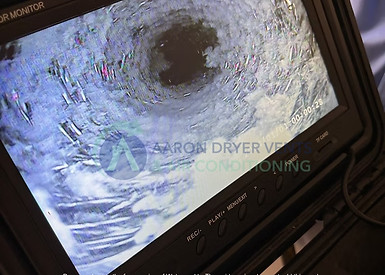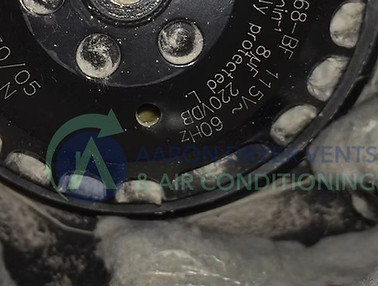
Dryer vent systems come in many forms — from single homes to high-rises with shared stacks. Each layout requires a different cleaning method, safety consideration, and scheduling approach. Explore the options below to learn what to expect and how we can help keep your system safe and efficient.

Single Homes
Single-family homes usually have a dedicated vent line that runs from the dryer to an outside wall or the roof. While these systems are simpler than shared stacks, they still face common issues that can reduce efficiency and pose serious fire risks. What we look for: Lint buildup inside the pipe can restrict airflow and cause the dryer to overheat. Bird nests, insects, or rodents may enter through the exhaust, creating additional blockages. Water can accumulate in low points or sagging vent lines, further hindering airflow. Disconnected or crushed hoses behind the dryer often go unnoticed and reduce ventilation efficiency. Exterior vent flaps may become stuck closed or damaged, preventing proper exhaust. In some cases, protective screens or covers become clogged and block airflow entirely. ⸻ The Process: We use rotary brushes, compressed air, and retrieval tools to clear the entire vent line. If needed, we also inspect the system with a camera to confirm airflow or check for deeper issues. Whether your vent exits through the wall or the roof, we ensure a clean, safe, and fully functional system. ⸻ Scheduling: Appointments typically take less than an hour. Please make sure we have access to the laundry area and any outdoor vent covers. If the dryer is stacked or in a tight space, let us know in advance so we can plan accordingly.
Many multi-level buildings use vertical dryer vent stacks that connect multiple units to a shared exhaust point—typically on the roof. These systems are common in condominiums, apartment buildings, and older high-rises. While they save space, they also present unique cleaning and maintenance challenges. What Makes Stack Systems Different: Multiple units share the same vertical exhaust line. Vent paths often include offsets, which can trap lint and reduce airflow. Access is limited—cleaning is usually done from the roof or through clean-outs. Roof-mounted exhaust fans are often used to assist airflow and require routine maintenance. Because of the shared layout, a blockage or fan failure can affect several units at once. Routine maintenance is essential to avoid slow drying times, overheating, and fire hazards. ⸻ The Process: Cleaning is performed remotely using specialized tools such as compressed air, rotary brushes, and retrieval devices. We also use a tilt-pan inspection camera to assess airflow, identify internal blockages, and confirm cleaning results—especially in complex or offset vent runs. All cleaning is typically done from accessible points such as the roof or dedicated clean-outs, without needing to enter individual units. In some cases, access is required from inside apartments, especially where there are no clean-outs or when blockages are located near the unit’s connection to the stack. When offsets are present, clean-outs are often needed just before or after those directional changes. We typically install fire-rated access doors to ensure safe and code-compliant access to these areas. Over the years, we’ve found a wide range of unexpected obstructions inside vent stacks—including construction debris, personal items, and materials from apartment renovations. In some cases, moisture-damaged sheetrock inside shared walls has deteriorated and collapsed into the stack, partially or completely blocking airflow. Our inspection tools and experience allow us to spot these issues early and address them before they cause system-wide airflow problems or safety risks. ⸻ Scheduling & Planning: We highly recommend a camera inspection before scheduling a stack cleaning. It helps identify potential access points, confirm the condition of the system, and ensure the cleaning plan is both effective and efficient. Services are scheduled by stack, not individual unit Roof and clean-out access may be required Roof exhaust fans should be inspected and maintained annually Before/after documentation available upon request
Dryer Vent Cleaning for Multi-Unit Communities We provide professional dryer vent cleaning services for rental communities, condominiums, and homeowner associations, with flexible options designed to meet the unique needs of multi-unit properties. Dryer vent layouts in these communities vary — some units have individual vent lines, while others may share a vertical stack, a common rooftop exhaust vent, a fan-assisted system, or even a passive wind turbine. Because of these differences, cleaning and maintenance strategies must be tailored to each property. We offer two levels of service to match your building’s configuration and maintenance goals: ⸻ Routine Cleaning Our routine cleaning is ideal for well-maintained systems with no known issues and is commonly selected when service is limited to the shared or exterior portions of the dryer vent system. Cleaning is performed from the outside vent using tools like compressed air snakes, rotary brushes, hooks, and retrieval equipment It does not include access to the dryer connection inside each unit Eliminates the need to coordinate interior access with every resident Residents who want full-service cleaning inside their unit can schedule separately This option is best for communities that perform regular cleanings or want a convenient, non-intrusive service across multiple units. ⸻ Comprehensive Cleaning Our comprehensive cleaning includes access to the dryer connection inside each residence and is recommended for: Units with limited maintenance history. Signs of airflow restriction or long drying times. Communities that want to ensure the entire vent path is cleaned from end to end. This service is more thorough and may require scheduled access to units, but it provides the most complete results and helps prevent long-term issues caused by hidden buildup or blockages. ⸻ Flexible for Your Community Whether you’re managing 10 units or 500, we can tailor a plan that fits your property’s layout, scheduling needs, and service goals. We work directly with managers and boards to coordinate efficient, professional cleanings with minimal disruption. Camera inspections may also be used as needed to identify blockages.
Video Inspections for Problem Solving & Quality Control Our camera inspection system allows us to see inside dryer vents without invasive access. It helps identify blockages, crushed or disconnected lines, poor airflow, and improper installations, as well as confirm cleaning results with visual documentation. Camera inspections are especially useful in: High-rise stacks or shared systems. Long vent runs with offsets or elbows. Situations where dryers are still underperforming after cleaning. Properties needing visual documentation for property managers or insurance records. This tool is also valuable for preventative maintenance, helping detect early signs of trouble before they cause airflow problems or safety hazards.
Booster Fans
Dryer Vent Booster Fans, Purpose & Maintenance: Dryer vent booster fans are installed to improve airflow in vent runs that are too long or restrictive for the dryer to exhaust properly on its own. These fans actively pull air through the duct system, helping to prevent lint buildup, reduce drying times, and protect dryer performance. Booster fans are commonly used in vent runs longer than 25 feet, in multi-unit buildings with centralized vent paths, or in homes and condos where the dryer is located far from an exterior wall. ⸻ Why Maintenance is So Important: Without regular maintenance, booster fans can develop serious problems that reduce system performance and lead to expensive repairs. In systems that haven’t been serviced, condensation from hot dryer air can collect inside the fan housing. This moisture buildup can cause the motor to fail, often requiring full replacement of the fan assembly. In addition, lint naturally accumulates on the fan blades over time. As it builds up, the fan becomes unbalanced and begins to vibrate. This out-of-balance condition adds stress to the motor and shortens its lifespan. Lint buildup also restricts airflow, which reduces the dryer’s efficiency, increases energy use, and leads to longer drying times. These issues are often overlooked until the fan fails or the dryer begins to underperform. ⸻ Our Recommendation: We recommend annual inspection and cleaning of booster fans to keep the system running efficiently. During service visits, we check for signs of moisture or corrosion, clean the fan blades and housing, and verify that airflow and motor performance are within proper range. Proper maintenance ensures your booster fan continues to operate safely and effectively — extending the life of your equipment and supporting overall dryer system performance.




